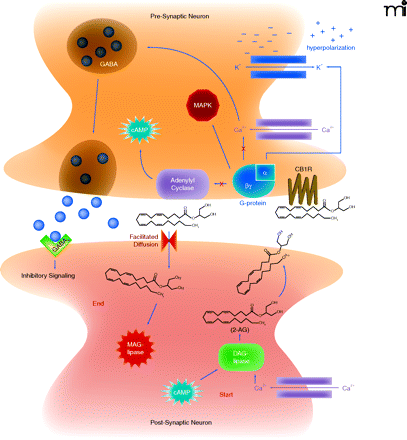Marijuana-based Drugs: Innovative Therapeutics or Designer Drugs of Abuse?

Endocannabinoids are produced on demand in post-synaptic neurons by stimuli that result in elevations of intracellular Ca2+ levels, activating synthetic enzymes such as diacylglycerol lipase (DAG-lipase). Synthesized endocannabinoids such as 2-arachidonyl glycerol (2-AG) then diffuse into the synaptic space, travel in a retrograde manner, and bind to CB1Rs on presynaptic neurons. Retrograde signaling produced by endocannabinoid binding to presynaptic CB1Rs results in inhibition of adenylyl cyclase and activation of mitogen-activated protein kinase (MAPK) activity. However, the inhibitory actions of cannabinoids on neurotransmission result primarily from hyperpolarization of presynaptic neurons resulting from inhibition of Ca2+ influx via voltage-gated Ca2+-channels and loss of intracellular K+ ions via opening of inwardly rectifying cannels. Hyperpolarized presynaptic neurons produce less exocytosis of neurotransmitter, such as γ–aminobutyric acid (GABA), resulting in decreased neurotransmission. Endocannabinoid actions are finally terminated by hydrolysis due to action of presynaptically located metabolizing enzymes such as monoacylglycerol lipase (MAG-lipase).



